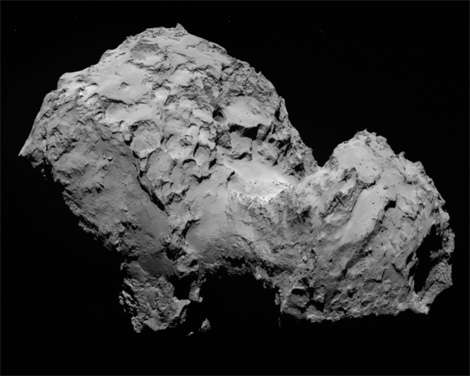Does the organic material of comets predate our solar system?

The Rosetta space probe discovered a large amount of organic material in the nucleus of comet 'Chury.' In an article published by MNRAS on Aug. 31, 2017, two French researchers advance the theory that this matter has its origin in interstellar space and predates the birth of the solar system.
The ESA's Rosetta mission, which ended in September 2016, found that organic matter made up 40% (by mass) of the nucleus of comet 67P Churyumov-Gerasimenko, a.k.a. Chury. Organic compounds, combining carbon, hydrogen, nitrogen, and oxygen, are building blocks of life on Earth. Yet, according to Jean-Loup Bertaux and Rosine Lallement—from the Laboratoire Atmosphères, Milieux, Observations Spatiales (CNRS / UPMC / Université de Versailles Saint-Quentin-en-Yvelines) and the Galaxies, Étoiles, Physique et Instrumentation department of the Paris Observatory (Observatoire de Paris / CNRS / Université Paris Diderot), respectively—these organic molecules were produced in interstellar space, well before the formation of the Solar System. Bertaux and Lallement further assert that astronomers are already familiar with much of this matter.
For 70 years, scientists have known that analysis of stellar spectra indicates unknown absorptions, throughout interstellar space, at specific wavelengths called the diffuse interstellar bands (DIBs). DIBs are attributed to complex organic molecules that US astrophysicist Theodore Snow believes may constitute the largest known reservoir of organic matter in the Universe. This interstellar organic material is usually found in the same proportions. However, very dense clouds of matter like presolar nebulae are exceptions. In the middle of these nebulae, where matter is even denser, DIB absorptions plateau or even drop. This is because the organic molecules responsible for DIBs clump together there. The clumped matter absorbs less radiation than when it floated freely in space.
Such primitive nebulae end up contracting to form a solar system like our own, with planets . . . and comets. The Rosetta mission taught us that comet nuclei form by gentle accretion of grains progressively greater in size. First, small particles stick together into larger grains. These in turn combine into larger chunks, and so on, until they form a comet nucleus a few kilometers wide.
Thus, the organic molecules that formerly populated the primitive nebulae—and that are responsible for DIBs—were probably not destroyed, but instead incorporated into the grains making up cometary nuclei. And there they have remained for 4.6 billion years. A sample-return mission would allow laboratory analysis of cometary organic material and finally reveal the identity of the mysterious interstellar matter underlying observed absorption lines in stellar spectra.
If cometary organic molecules were indeed produced in interstellar space—and if they played a role in the emergence of life on our planet, as scientists believe today—might they not also have seeded life on many other planets of our galaxy?
More information: Jean-Loup Bertaux et al, Diffuse Interstellar Bands carriers and cometary organic material., Monthly Notices of the Royal Astronomical Society (2017). DOI: 10.1093/mnras/stx2231
Journal information: Monthly Notices of the Royal Astronomical Society
Provided by CNRS





















